A brief history of wind tunnels around the world (with a map of wind tunnels around the world)

Brian Riddle, former chief librarian of the Royal Aeronautical Society’s National Aviation Library, looks back at the early years of wind tunnels, a 150-year history of wind tunnels that began with the Royal Aeronautical Society’s experimental wind tunnel project.
“The wind tunnel undoubtedly ranks among the most important instruments and tools ever developed in the entire history of mankind,” said Richard P Hallion, leading aviation historian.
1871 – 150 years ago – the world’s first wind tunnel was built under the auspices of the British Aeronautical Institute.
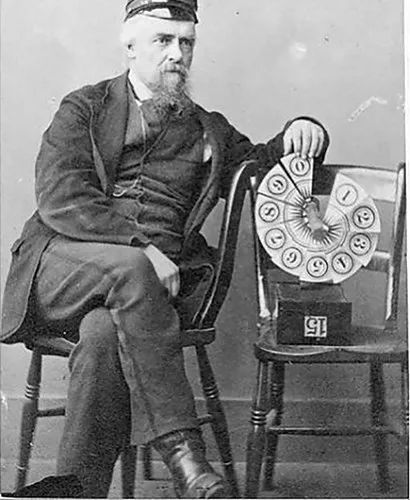
Francis Herbert Wenham
(Royal Aeronautical Society/National Aviation Library)
The wind tunnel was designed by Francis Herbert Wenham (1824–1908). He was one of the most influential figures in the world of aviation before the Wright brothers. He not only conducted in-depth research on curved wings and wing aspect ratios, but also gave the first lecture on “Mechanical Motion in the Air” to the Society on June 27, 1866. The Society’s minutes of July 13, 1870 indicate that Wenham was a member of a committee for experimental purposes. In the minutes of July 3, 1871, the Experimental Committee reported that the instrument designed by Mr. Wenham was intended to explore the relationship between speed and pressure at different angles.
Start with the blower
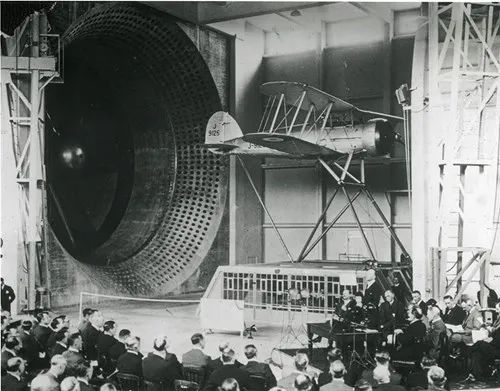
A Gloster SS19B aircraft in the 24ft wind tunnel at Farnborough.
(Royal Aeronautical Society/National Aviation Library)
The Society decided that the equipment to be sent for “the necessary blower tests” would be made by John Penn, a manufacturer of optical and physical instruments, and Sons Marine Engineering of Greenwich, a manufacturer of industrial ventilating fans. The cost was “about £25” (equivalent to £3,000 today). The Royal Aeronautical Society’s Minutes of 5 February 1872 reported that the Experimental Committee had completed “the first work (tests) … and was arranging the results of the experiments”, and that the first public exhibition of the “new machine for measuring the relation between velocity and pressure …” would be held at the General Assembly of the Royal Aeronautical Society on Tuesday 18 April 1872 in the Literary Section of the Society.
At the meeting, Wenham described it as “working on the same principle as the ordinary anemometer, measuring the force of the wind blowing perpendicularly to a plane by a series of ‘plates’ fixed on a horizontal arm”, which were adjustable in angle and vibrated according to the impact of the air. Two years later, at the meeting of the Society on Tuesday, May 15, 1874, Thomas Moy reported on “precious experiments … carried out at the factory of Messrs. Penn, Greenwich … which have contributed more to aviation than he expected, and have produced upward pressures at small angles of attack than were then anticipated by the existing theory. From the data furnished by these experiments, Mr. Moy has drawn a graph showing the variation of pressure with angle of attack for winds from 10 to 40 miles per hour”.
History of British Wind Tunnels
In the UK, aeronautical research – overseen by the Advisory Committee for Aeronautics (ACA) established by Lord Haldane in April 1909 – centred primarily around two sites in the early decades of the 20th century – the National Physical Laboratory (NPL) at Teddington and the Royal Aircraft Factory/Farnborough:
1903: Thomas Stanton builds the first wind tunnel at NPL.
1907: The first wind tunnel was built at the Balloon Works in Farnborough to NPL’s design (20 feet long and 5 square feet in cross section).
1917: Two 7-foot wind tunnels were built at Farnborough.
1919: NPL builds a twin-section wind tunnel.
1933: High-pressure wind tunnel begins operation at NPL.
1935: A 24-foot diameter wind tunnel is unveiled at Farnborough.
Before Wenham, the most important aeronautical theorist of his time was Sir George Cayley (1773-1857). He first used the gyrocopter designed by Benjamin Robins in 1746 (built by John Ellicott) to measure air resistance and explore the effect of angle of incidence on different airfoils. Wenham’s wind tunnel – and its equipment for collecting data on wings of different thicknesses, lengths and aspect ratios – represented a major step forward in the study of aerodynamic phenomena.
Higher wind speed
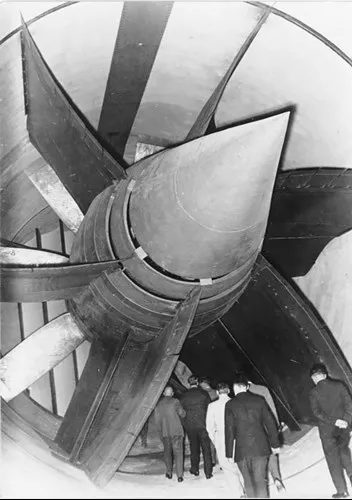
German wind tunnel in 1935
(Federal Archives)
In 1871, at the Mikhailov Artillery Academy in Saint Petersburg, Russia, V.A. Pashkevich designed and built a wind tunnel and a three-part aerodynamic balance.
History of wind tunnels in Europe
Early innovations in wind tunnels began in Europe, and during the following decade wind tunnels helped to achieve a number of important developments, including:
1893: Ludwig Mach, son of the famous scientist Ernst Mach, built a 7-inch by 9.75-inch wind tunnel in Vienna specifically for filming air movement, pioneering the use of video technology to study air flow.
1894: Henrik Christian Vogy (1848-1928), a marine engineer, with the help of Johannes OV Irminger (1848-1938), studied the distribution of air pressure on flat plates and various surfaces in a wind tunnel (40 inches long and 4.5 inches by 9 inches in cross section) at the Eastern Gasworks in Copenhagen.
1896: At the central military base of Chalais-Meudon, its commander Charles Renard (1847-1905) built a wind tunnel 13 feet long and 31 inches in diameter to study the stability of airships.
1847-1897: Poul la Cour (1846-1908) of Askov, Denmark, used two small wind tunnels for research on windmills and wind turbines. (The Danish Aerodynamic and Acoustic Wind Tunnel at DTU is named after him).
1896-1897: Konstantin Eduardovich Tsiolkovsky (1857-1935) – later known as the “Father of Soviet Rocketry” – built a small wind tunnel at Borovsk near Moscow as part of his research into designing a large metal airship that could carry 200 people. Similar to Wenham’s design, this wind tunnel also used a single-component balance to measure the coefficient of drag.
1899: In France, Étienne-Jules Marey (1830-1904) expands his research on bird flight by photographing air currents over objects of various shapes using rapid sequence photography and by passing smoke through a wind tunnel.
The next milestone was reached in 1884 when Horatio Frederick Phillips (1845-1926) designed his own wind tunnel – six feet long and 17 square inches in cross section – to test the curvature and efficiency of different airfoils. The article “Experiments in the Flow of Air” published in Engineering magazine on 14 August 1885 described Phillip’s wind tunnel as ‘… a rectangular piece of wood … open at the front and connected at the rear by a gradually widening iron duct’, through which air was drawn by a system of steam injections, effectively incorporating a diffuser into the wind tunnel: “The results obtained … are, we believe, the best yet obtained, and are in close agreement with the highest results obtained at Greenwich…” As Octave Chanute (1832-1910) noted in his book The Progress of the Flying Machine – an important achievement in the development of early aviation – Phillip’s experiments “…deduced that convex and concave surfaces could produce much greater support than the flat surfaces previously designed for aircraft”.
Spread across the UK
Back in England, Hiram Maxim (1840-1916) built a huge biplane on the grounds of Baldwyns Park in Kent from 1891-1894, and completed a brief uncontrolled powered “jump” flight in 1894, just a short distance from the runway. At first, Maxim used data from a huge rotating arm to assist his design, but its limitations led him to build an “instrument for measuring the lift of airplanes and condensers in blowers” – a wooden box “… 12 feet long, with an interior of exactly 3 square feet… connected to… a shorter box of 4 square feet” – and equipped with two propellers placed vertically and horizontally, powered by a 100 horsepower steam engine. Maxim pioneered the use of wooden strips – placed horizontally, vertically and diagonally in a wind tunnel – to straighten the airflow, thereby “ensuring… the effect of lift for different forms and speeds of wind, and the drag of different objects passing through the air.”
Blowing machine
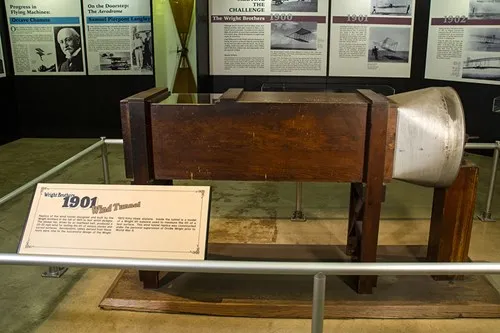
The Wright brothers’ wind tunnel of 1901
(National Museum of the United States Air Force)
Outside of Europe, in 1893, Professor William Charles Kernot (1845-1909) built the first wind tunnel – a ‘machine for blowing air’ – at the University of Melbourne, Australia, to study wind forces on buildings. In 1896, Alfred J. Wells, a mechanical engineering student at MIT, built the first wind tunnel in the United States – 30 square inches – as part of his graduate project.
On December 17, 1903, the Wright brothers—Wilbur (1867-1912) and Orville (1871-1948)—achieved the world’s first piloted, sustained, controlled, powered flight of a heavier-than-air machine from four hills at Kill Devil, near Kitty Hawk, North Carolina. Orville Wright was at the controls of the Wright Flyer. Their achievement was based on years of wind tunnel experiments with different wing surface configurations—as well as their own kite and glider designs—and their second wind tunnel (a six-foot-long, 16-square-inch cross-section wooden box) tested more than 200 airfoil models at varying scales, ‘and it was this ingenious machine that enabled the Wright brothers to unlock the secrets of the wing.’
History of American Wind Tunnels
The following decades saw the rapid development of wind tunnels in the United States, with an increasing number of research and academic institutions offering courses in aerospace, including:
1913: Jerome Hunsaker, with the help of Edward P. Warner and Donald Wills Douglas, builds a wind tunnel based on the NPL design at MIT.
1918: The U.S. Army builds its first wind tunnel at McCook Field in Ohio for testing high-speed instruments and airfoils.
1920: The first NACA wind tunnel, No. 1, begins operation in Langley, Virginia.
1923: A variable-density wind tunnel is built in Langley, Virginia.
1927: The Propeller Research Tunnel (PRT) begins operation in Langley, Virginia.
1929: A 5-foot vertical wind tunnel is built in Langley, Virginia, to study the rotational characteristics of aircraft.
1930: A 7-foot by 10-foot atmospheric wind tunnel (AWT) is built in Langley, Virginia.
1931: NACA builds a full-scale wind tunnel at Langley City to test full-scale aircraft—a 30-foot by 6-foot test section housed in a nine-story building. It was the largest wind tunnel in the world at the time and was scheduled to operate until September 4, 2009.
1936: An 8-foot high-speed wind tunnel (HST) is built in Langley, Virginia.
1938: Langley, Virginia, has a 19-foot pressure wind tunnel (later converted to a 16-foot transonic wind tunnel (TDT) in the 1950s).
1938: The Wright brothers’ high-pressure wind tunnel—based on Ludwig Prandtl’s recirculation design originally developed in Göttingen in 1908—is developed by Daniel Guggenheim’s School of Aeronautics and Astronautics at MIT to simulate atmospheric conditions at varying wind speeds/altitudes.
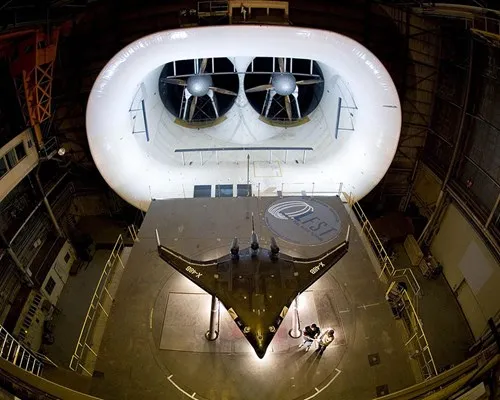
Blended wing model aircraft in NASA wind tunnel
(NASA)
Europe led the world in wind tunnel research until the 1920s, with individual pioneering efforts in the 19th century based on funding from national governments and individuals such as Gustave Eiffel and Henri Deutsche de la Meurthe.
Based on the European experience, the U.S. Congress established the National Advisory Committee for Aeronautics (NACA) in March 1915. The national shortage of wind tunnels was particularly concerning given that the United States had only two such facilities in 1910—one was the Wright brothers’ wind tunnel in Dayton, Ohio, and the other was Dr. Albert Francis Zahm’s 1901 wind tunnel at the Catholic University of America in Washington, D.C. (it was 40 feet long, 6 square feet in cross-section, and powered by a 12-horsepower electric fan).
The 1930s saw the development of more aerodynamically efficient aircraft designs – a reflection of the development of wind tunnels, with the 1931 Douglas DC-1 airliner’s streamlined design thanks to extensive wind tunnel testing in the 10-foot wind tunnel developed in 1929 at the Guggenheim Aeronautical Laboratory at the California Institute of Technology (CALCIT).
Supersonic speeds and beyond
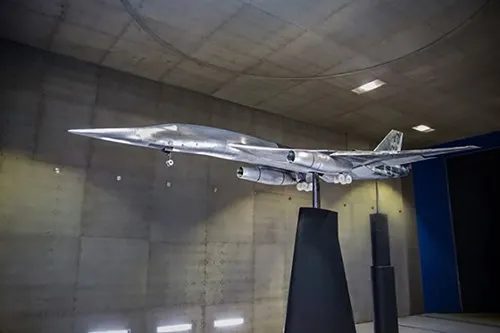
Aerion AS2 Supersonic Business Jet SSBJ (Aerion) in the ONERA Wind Tunnel
Research into high-speed aerodynamics (including swept and delta wings) also inspired faster and more efficient designs. Jacob Ackeret (1898-1981) built the first wind tunnel capable of reaching Mach 2 at the Institute of Aerodynamics in Zurich, Switzerland, between 1935 and 1936. A much larger supersonic facility was built at Peenemünde, Germany, for use in the A-4/V-2 rocket research.
China’s first wind tunnel—a 15-foot-long, 18-foot-long additional duct built at Tsinghua University in Beijing for full-scale engine and propeller testing—became operational in 1938. The Institute of Aeronautics at Tokyo Imperial University was already equipped with a wind tunnel when it opened in 1921.
Beginning with Francis Wenham’s pioneering design, the evolution of the wind tunnel—which revolutionized the fundamental understanding of aerodynamics and fluid mechanics—has truly grown around the world.
Appendix – Global distribution of wind tunnels
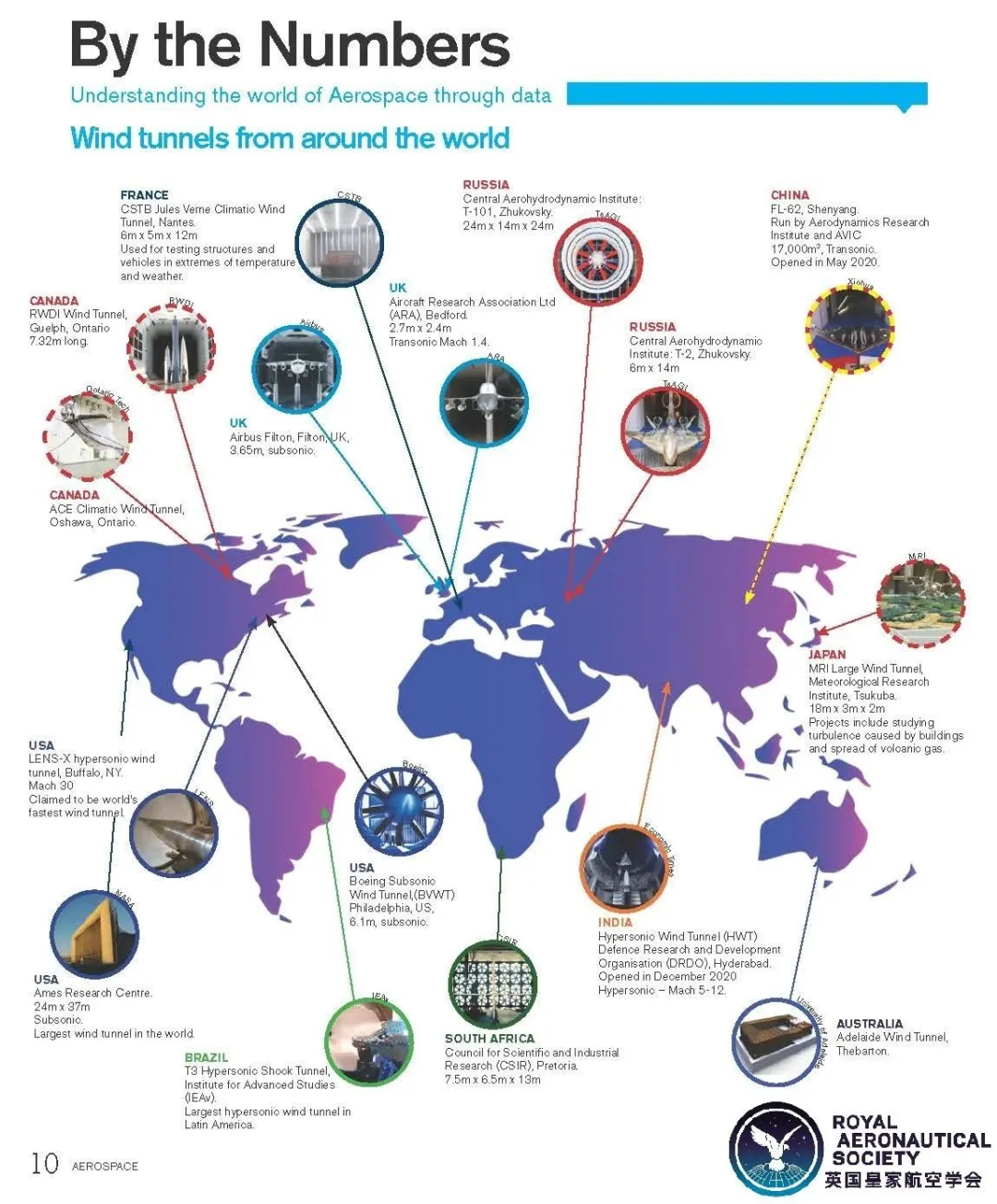
This article is excerpted from the April issue of AeroSpace, the monthly magazine of the Royal Aeronautical Society
Translation: Fei Zheni





